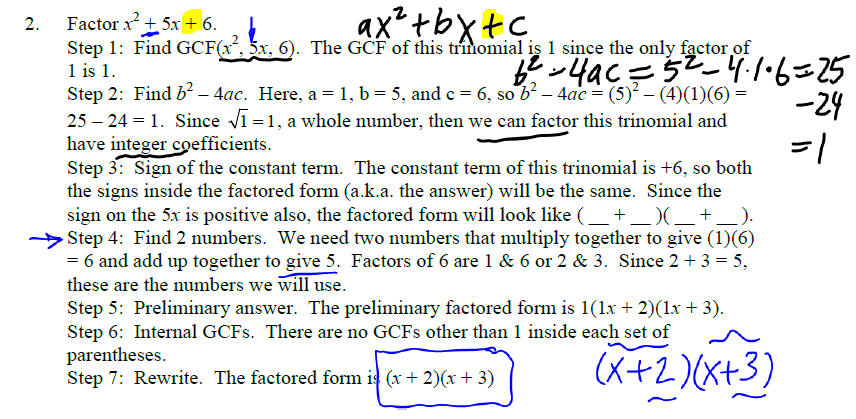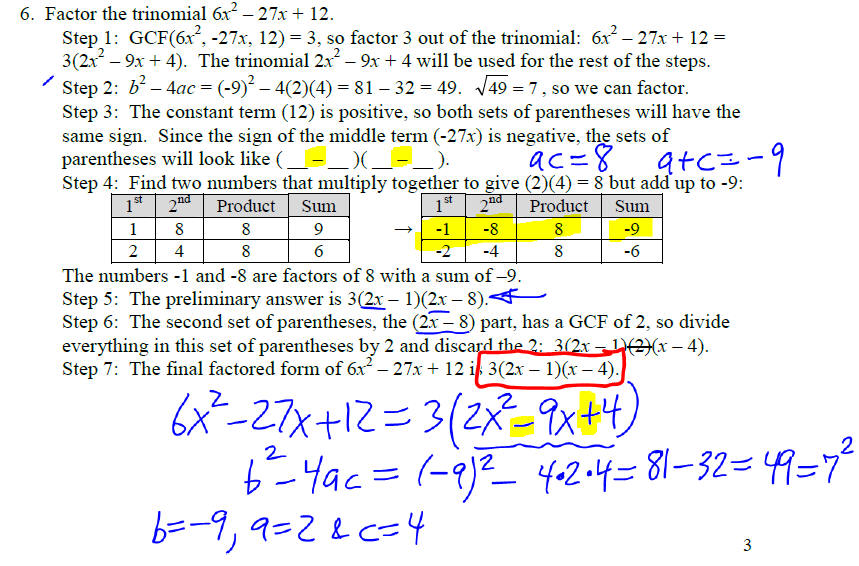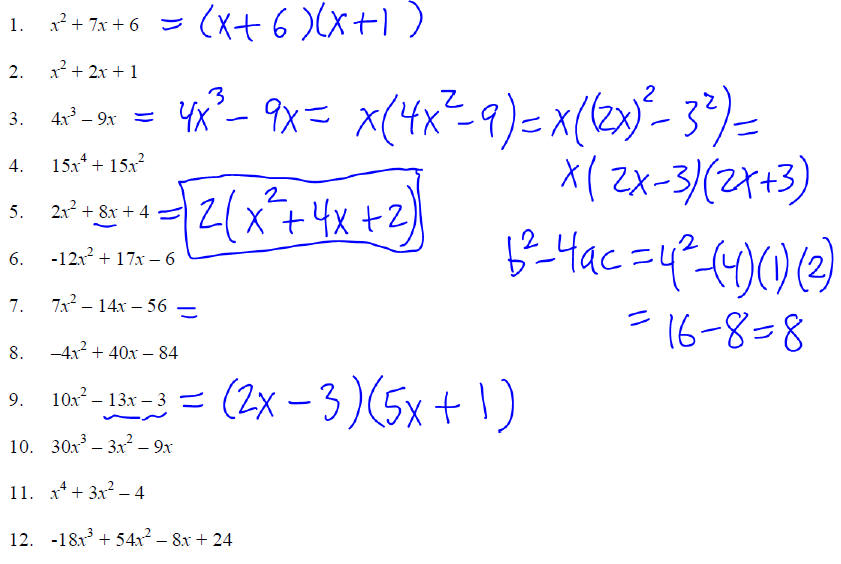Factoring Polynomials
Some trinomials that can be factored do not look like the
special trinomials from the
previous sections . Factor trinomials, written ax^2 + bx + c, by doing the
following rules :
1. Factor out the GCF of all three terms. Use the
resulting trinomial for the rest of
the steps . If a is negative, also factor out –1 along with the GCF.
2. Check that the square root of b ^2 – 4ac is a whole
number. If b^2 – 4ac is negative,
then we cannot factor the trinomial. If the square root of b^2 – 4ac is not a
whole
number, then the factored form of ax^2 + bx + c will have fractions or square
root
signs in it . We will not be factoring these in this section.
3. Look at the sign of the constant term.
a. If the second sign (the one before the constant term) is a + sign, then both
signs
in the factored form are whatever the first sign is.
ax^2 + bx + c = ( __ + __ )( __ + __ )
or
ax^2 – bx + c = ( __ – __ )( __ – __ )
b. If the second sign is a – sign, then the signs in the
factored form are different .
ax^2 + bx – c = ( __ + __ )( __ – __ )
or
ax^2 + bx – c = ( __ + __ )( __ – __ )
4. Find two numbers that multiply together to give ac but
add up to give b. Keep the
signs of a, b, and c with the numbers.
5. Rewrite in preliminary factored form:
a. Write the GCF on the outside of the factored form.
b. In both sets of the parentheses, write ax
c. Write the appropriate signs from step 3.
d. Write the two numbers found in step 4, one in each set of parentheses.
6. Factor out any GCFs from the sets of parentheses and
throw them away.
7. Rewrite. This is the final factored form.
Examples:
1. Factor 3x^2 + 5x + 4.
Step 1: Find GCF(3x^2, 5x, 4). The GCF is 1 since none of the coefficients have
a
factor in common.
Step 2: Find b^2 – 4ac. In this trinomial, a = 3, b = 5, and c = 4, so
b^2 – 4ac = (5)^2 – (4)(3)(4) = 25 – 48 = -23. Since -23 is negative, we cannot
factor
this polynomial.

3. Factor the polynomial x^2 – 5x – 24.
Step 1: GCF(x^2, -5x, -24) = 1.
Step 2: b^2 – 4ac = (-5)^2 – 4(1)(-24) = 25 + 96 =
121.  , so we can factor this polynomial.
, so we can factor this polynomial.
Step 3: The sign of the constant term is negative,
so the signs inside the sets of
parentheses will be different, ( __ + __ )( __ – __ )
Step 4: We want 2 numbers that multiply together to
give (1)(-24) = -24 and add up
to -5. Factors of -24 and their sums are

The numbers 3 and -8 multiply together to give -24 and add
up to -5.
Step 5: The preliminary answer is 1(1x + 3)(1x – 8).
Step 6: Neither set of parentheses have a GCF other than 1.
Step 7: The answer is (x + 3)(x – 8).
4. Factor x^2 + 10x + 18.
Step 1: GCF(x^2, 10x, 18) = 1.
Step 2: b^2 – 4ac = (10)^2 – (4)(1)(18) = 100 – 72 = 28. Since 28 is not a
perfect
square (the square root of 28 is not a whole number), we cannot factor this
trinomial
and have only integer coefficients in our answer. This trinomial is in its final
factored form.
5. Factor 2x^2 + 18x – 72.
Step 1: GCF(2x^2, 18x, 72) = 2. We must factor 2
out of our trinomial:
2x^2 + 18x – 72 = 2(x^2 + 9x – 36). Use the trinomial inside the parentheses for
the
rest of the problem.
Step 2: b^2 – 4ac = (9)^2 – 4(1)(-36) = 81 + 144 =
225. Since  , we can
, we can
continue with factoring
Step 3: The constant term is negative, so the signs
inside the sets of parentheses in
our answer will be opposite; that is, ( __ + __ )( __ – __ ).
Step 4: Find 2 numbers that add up to +9, but multiply to get (1)(-36) = -36:

The numbers -3 and 12 multiply together to get -36 and add
together to get 9.
Step 5: The preliminary answer is 2(1x + 12)(1x – 3).
Step 6: Neither set of parentheses have a GCF other than 1.
Step 7: The factored form is 2(x + 12)(x – 3).

7. Factor –20x^3 – 80x^2 – 75x.
Step 1: GCF(-20x^3, -80x^2, -75x) = -5x. Since the
coefficient of the term with the
highest order is negative, we want to pull the negative out along with the GCF.
Factor out the -5: -20x^3 – 80x^2 – 75x = -5x(4x^2 + 16x + 15).
Step 2: b^2 – 4ac = (16)^2 – 4(4)(15) = 256 – 240 =
16. Since 16 is a perfect square,
we can factor the trinomial 4x^2 + 16x + 15.
Step 3: The constant and the middle terms are
positive, so 4x^2 + 16x + 15 will factor
into something that looks like ( __ + __ )( __ + __ ).
Step 4: Find two numbers that multiply to give (4)(15) = 60 but add up to 16:

The numbers 6 and 10 are factors 60 and have a sum of 16.
Step 5: The preliminary answer is -5x(4x + 10)(4x + 6).
Step 6: Both sets of parentheses have GCFs greater than one. GCF(4x, 10) = 2 and
GCF(4x, 6) = 2. Divide everything in the first set of parentheses by 2 and
everything
in the second set of parentheses by 2, throwing away the GCFs afterward:

Step 7: Rewrite; the answer is -5x(2x + 5)(2x + 3).
Factor the following polynomials using any method . The
answer should have only
integer coefficients.

| Prev | Next |